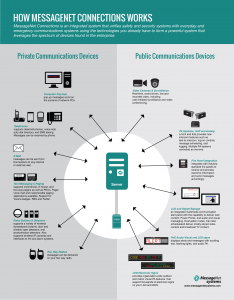The MessageNet Blog
Get The Message Out!
How to Apply the Intel Security Patch
If your MessageNet server is a black 4U server, it has an AMD processor in it and is not affected by the recent Intel security flaws. However, if your server is a newer silver 1U Dell server, then the processor is by Intel and may be affected by the security flaws. Any patches to fix this issue would be at the hardware level, provided by Dell on their website, and would therefore need to be applied directly on the server by someone on-site and cannot be done remotely by MessageNet support staff. Note: It is possible that applying a patch may cause the server to slow down by up to 40%.
How to Back Up Server Data
In order to avoid risking lost data in the event of a server failure, it’s very important to have a complete backup of all of the MessageNet server’s data. Because every customer’s system, network, and organization are different, MessageNet cannot provide or suggest a backup method. However you decide to back up your data, however, it’s important to backup everything, as data restoration may be impossible without a full backup. A full backup includes everything in the server’s root partition and home partition. The paths for these two partitions are:
/
/home
Best Practices for a Safe Environment
Last week, I wrote about how important it is to have a plan for emergency events. More lives are saved when a plan is in place and everyone knows what to do, rather than simply reacting to the situation.
The Council of Educational Facilities Planners International have released Safe Schools: A Best Practices Guide, for that very reason. The guide, available in PDF form for free online, emphasizes the need for communication in a crises. In fact, page 7 of the guide is titled Crisis Communications.
The guide lists recommended devices, including PA, cameras, multiple communication devices, broadcast messaging, and a plan, all of which MessageNet Connections can provide. We go a step further, however, and use the emergency system for everyday communications as well, to ensure that users won’t forget how to use the system before an emergency happened.
Don’t Be Surprised by Emergencies
While everyone hopes that emergency situations don’t arise, it’s important to not let one take you by surprise. According to Campus Security Magazine, your emergency alert system is ‘only as good as your plan’.
Having a plan in place for any possible emergency situations is important and can save lives. However, Campus Security also believes in testing your emergency communication system regularly. Though they see this practice as a requirement to ensure your system works properly if and when an emergency arises, it can involve considerable time and expense for your organization. Eliminating this cost is why MessageNet Connections isn’t designed to be just an emergency system. It’s also designed for every day communication; when used daily, users won’t forget how to use it in between emergencies and so that it’s effectively tested every day via constant use.
The article also discusses many different systems without talking about how they might work together. MessageNet Connections can integrate with many different types of systems, so it’s easier to unify communications and emergency alerts, rather than having many different emergency systems for different scenarios.
One integrated system that is used every day can save lives more easily and be cost-effective and more efficient at the same time.
Prepare For the Worst
All technology eventually fails. Cars, phones, tablets, computers, even MessageNet servers.
MessageNet Connections, which is often heavily relied upon for both everyday and emergency communications, is software and web browser-based. However, the hardware that supports it unfortunately cannot last forever. Many customers that have been with MessageNet for many years and have much older servers find that their hardware begins to fail; and the way they’ve got their system set up means that until they can purchase a new server, they’re completely without MessageNet services. In addition, if the server failure stems from the hard-drive, data may not be recoverable and the customer would have to start from scratch.
It’s important to have the right setup to protect data. MessageNet usually recommends having a redundant server setup so that if one server fails, there’s a second one to act as back-up. However, this isn’t always possible, so instead keeping a saved copy of the MessageNet hard-drive can prevent data loss and decrease down-time if a new server is needed.

 The MessageNet Connections software and licenses come with a no-risk, money-back guarantee. If you are unhappy with the software for any reason within 90 days of purchase, you may return the software for a full refund.
The MessageNet Connections software and licenses come with a no-risk, money-back guarantee. If you are unhappy with the software for any reason within 90 days of purchase, you may return the software for a full refund.